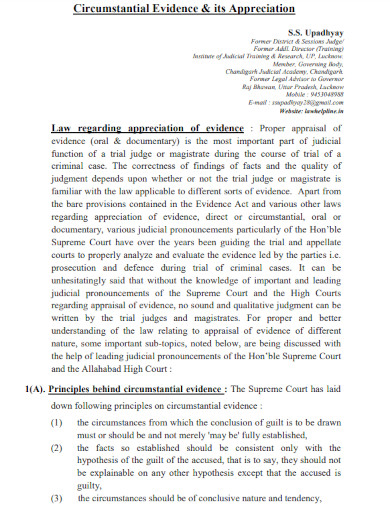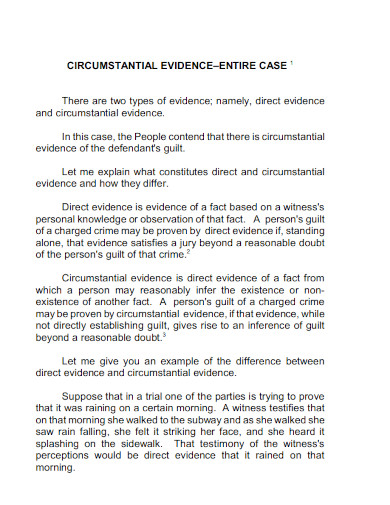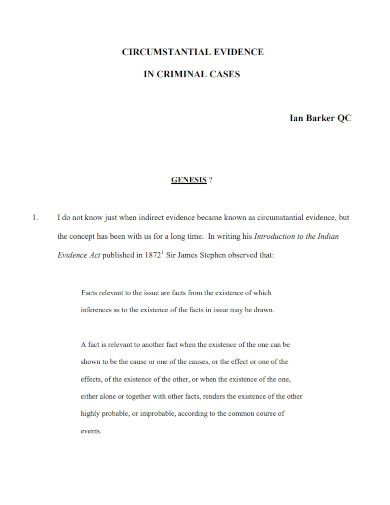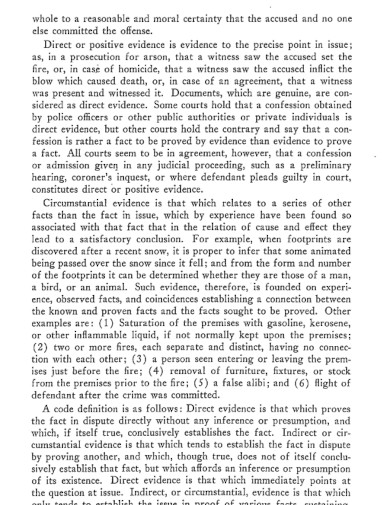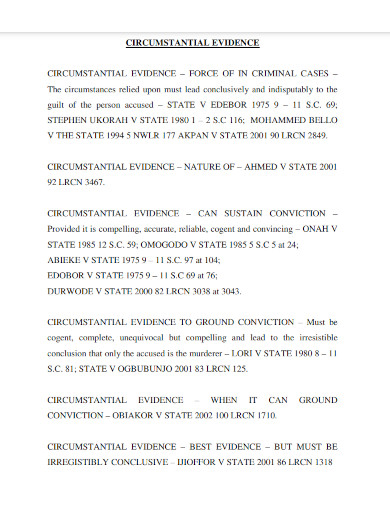Circumstantial Evidence Examples to Download
Someone’s guilt can be proven in a court of law by lawyers using a variety of evidence that can either placate or prove the guilt of the defendant. This evidence can either directly or indirectly orient the defendant’s position in court. One of the types of evidence used in court is called circumstantial evidence.
1. Circumstantial Evidence Appreciation
2. Namely, Direct Evidence and Circumstantial Evidence
3. Circumstantial Evidence in Criminal Cases
4. Circumstantial Evidence in Arson Cases
5. Circumstantial Evidence Template
What Are Circumstantial Evidence
Circumstantial evidence is a subtype of evidence that does not directly prove or disprove the defendant’s guilt via the jury’s inference of context. Biases from the lawyers’ side can directly affect the quality of the circumstantial evidence. Lawyers and researchers have practiced and used the scientific method to create and curate various skills and techniques, such as assertive communication, that will utilize circumstantial evidence to its fullest extent.
How to Identify Circumstantial Evidence From Other Types of Evidence
Circumstantial evidence is very hard to differentiate from direct evidence due to the undefined line between both types of evidence. If you want an exercise or a deeper understanding of how circumstantial evidence can impact a case then you may read the articles named Circumstantial Evidence in Criminal Cases, and Circumstantial Evidence in Arson Cases.
Step 1: Check the Type of Evidence Presented
Begin by checking the type of evidence presented by the lawyers in the court. If the evidence presented is forensic evidence or physical evidence, then it is immediately considered circumstantial evidence.
Step 2: Does the Evidence Directly Prove the Defendant’s Location at a Specific Timeframe Concerning the Crime
If the evidence presented is not one of those two types, then you will have to ask yourself whether or not the evidence directly proves the defendant being in said location. If the evidence does not prove the defendant’s location at that specific timeframe then you may consider the evidence as indirect evidence.
Step 3: Does the Evidence Directly Show the Defendant Doing an Action that Has Led to a Criminal Act
Same as the step above, you must ask yourself if the evidence directly proves the defendant has done a specific action or inaction that had led to the occurrence of a criminal act. If it does not, then you may categorize that evidence as circumstantial evidence.
Step 4: If the Evidence is a Witness Testimony, is the Witness Reputable and Trustworthy
If the evidence is witness testimony, you will need to question if the witness is reputable and trustworthy. Not only that but you will also need to question if the witness’ position is relevant to the evidence and case at hand. If proven otherwise then the witness testimony can be considered circumstantial evidence.
FAQs
Circumstantial vs. direct evidence; what is the difference between circumstantial and direct evidence?
Evidence is a type of proof that both sides of the court can bring up to prove the defendant guilty or not guilty. The judge and the jury can interpret the evidence based on whether or not they directly prove the defendant had committed an act that would lead up to the criminal act. Circumstantial evidence, also known as indirect evidence, is a type of evidence that indirectly implicates the defendant in a specific scenario that would lead up to the criminal act. This type of evidence can lead the jury to infer a scenario, which can lead to the defendant being found guilty, but due to the subjective nature of this evidence, other jurors and judges infer a different conclusion from said evidence. Direct evidence, on the other hand, is a type of evidence that objectively places the defendant in a specific position or scenario that would either help or damage the defendant’s case. The difference between both direct and circumstantial evidence is that direct evidence leaves little to no space for subjective interpretation, while circumstantial evidence is the main juxtaposition of that type of evidence.
What is the importance of circumstantial evidence?
Circumstantial evidence is a type of evidence that can be interpreted in various ways, which makes it weaker when compared to direct evidence. But this does not mean that circumstantial evidence is not important in court. This type of evidence when grouped or lined up together can try to either prove a fact brought up during the case or can lead to someone or a group of people concluding that a specific critical fact had occurred. The persecutor or the lawyer can even use circumstantial evidence to convict or acquit the defendant from the case due to the circumstantial evidence’s ability to lay down the different elements of the crime. All of these reasons indicate why circumstantial evidence is very useful in a court of law.
What are the types of circumstantial evidence?
Circumstantial evidence can come in many forms and types when the lawyer or persecutor brings this evidence to the court. One of the most common circumstantial evidence is in the form of forensic evidence. These usually present themselves as fingerprints, DNA evidence, and material examination. Another common example of circumstantial evidence is witness testimonies that do not directly implicate the defendant. Physical evidence is also another form of circumstantial as it may or may not implicate the defendant’s contribution to the crime.
Circumstantial evidence is one of the types of evidence that indirectly assumes the defendant’s actions or inactions, that may or may not have led to the criminal act from happening. This means that circumstantial evidence can lead to a conviction when the lawyer uses the evidence properly.



